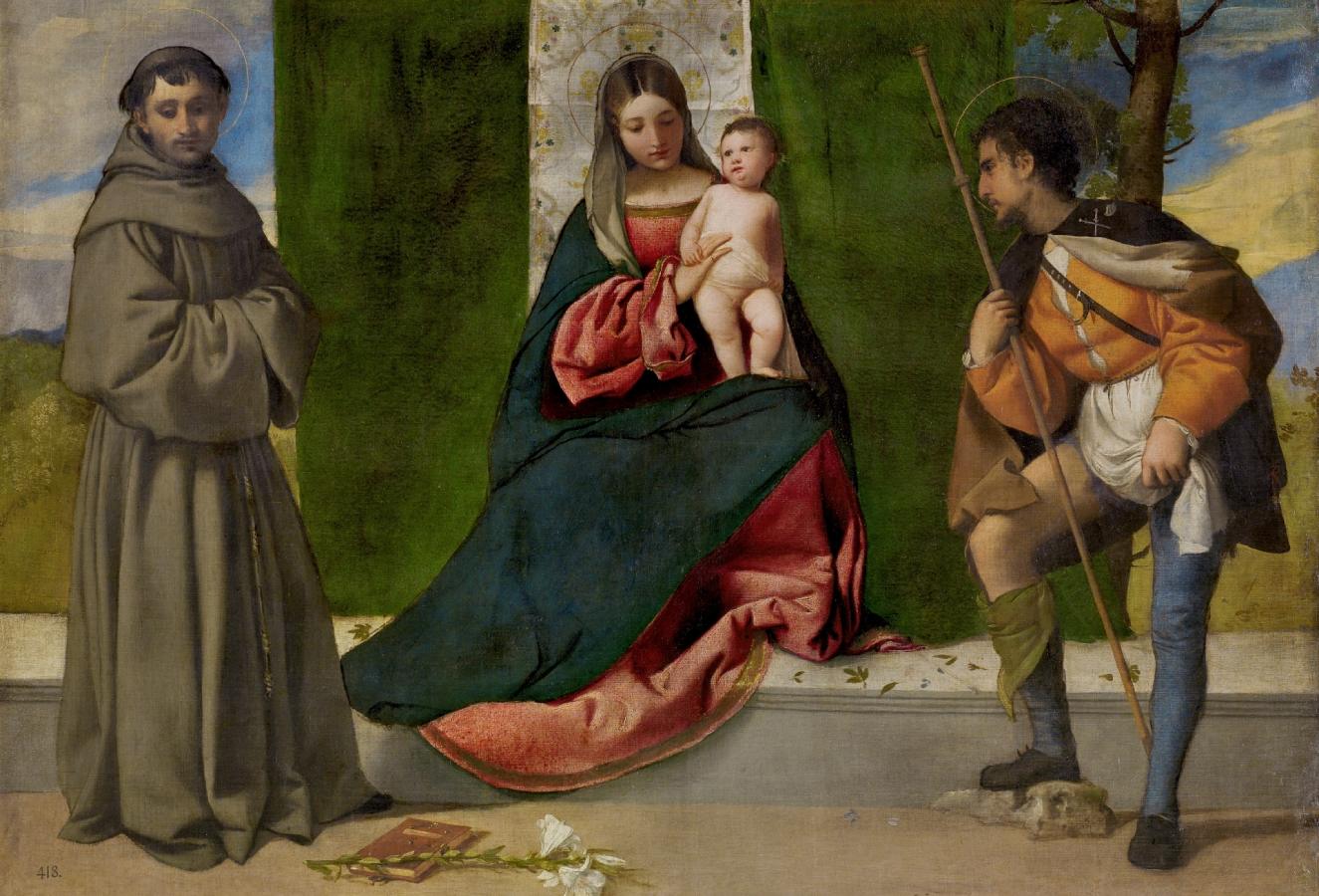Tiziano (c.1488-1576)
Madonna col Bambino tra i santi Antonio da Padova e Rocco (Virgin and Child with St. Anthony of Padua and St Roch)
c.1510
Oil on canvas, 92 x 133 cm
Museo del Prado, Madrid
This work was first recorded in 1641 as a work by Titian belonging to the Duke of Medina de las Torres in Naples. It was, however, attributed to Giorgione for centuries until Wilhelm Schmidt again attributed it to Titian in 1904. Most specialists now share Schmidt’s opinion, except for Charles Hope, who considers it the work of an artist yet to be determined, and Paul Holberton, who believes it to be by Domenico Mancini because of certain similarities between it and Mancini’s 1511 altarpiece at the Duomo di Lendinara. Mancini must have known Titian’s work, and that would explain the similarities, but the quality of his painting is significantly inferior to that of the present work. Titian must have painted The Virgin and Child between Saint Anthony of Padua and Saint Roch around 1508, possibly for the Scuola di San Antonio at the church of San Rocco in Venice, at a time when his relations with Giorgione were closest (both were then painting frescoes on the facades of the Fondaco dei Tedeschi), which would explain its strong resemblance to the latter’s work.
This is a reduced and simplified version of the Virgin and Child between Saint Nicasio and Saint Francis that Giorgione painted for the Duomo di Castelfranco around 1505. From that work Titian drew the symmetrical and pyramidal arrangement of the figures, the setting of the scene in front of a landscape, the inclusion of an architectural structure and the backdrop behind the Virgin. The latter’s physiognomy and the soft, sfumato surfaces are also derived from Giorgione, but he was not Titian’s only source of inspiration. The Virgin and Child are derived from an altarpiece that Giovanni Bellini painted for the church of San Zaccaria in Venice, while Saint Roch’s posture, with one leg resting on a rock, comes from the classical sculpture Apollo playing the kithara (Museo Archeologico, Venice). Gregorio de Gregoriis’s monumental wood engraving from 1517, The triumph of Christ, is based on drawings by Titian in which Saint Anthony of Padua clearly resembles his depiction in the present painting, while Saint George here recalls the profile of Saint Roch.
X-rays show various changes were made to the painting during its creation: originally, the curtains seemed to move more, while the Christ Child was looking at Saint Roch’s wound. The latter’s profile was also somewhat higher. Further small changes appear in Saint Anthony’s head, which was first turned to the left, and in the Virgin’s, which was in a lower position. Those changes reveal a shift in focus from Saint Roch to Saint Anthony, which is supported by the change in the Christ Child’s gaze. With his renowned modesty, Anthony avoids his attention. This painting is unfinished. While Saint Roch and the Christ Child are complete, the Virgin and her backdrop are not, and the landscape is barely sketched in. Reflectography shows drawing underneath Saint Roch’s profile, and on the contours and folds of the Virgin’s robe, but does not detect other drawing under the robe: the diagonal shading, suggesting areas of shadow, and another, more hasty and powerful area of drawing in the robe’s main folds. This is a technique derived from fresco painting, which served to help fix the aquamarine, a costly and unwieldy pigment. If Titian had applied the final coat of aquamarine to the robe, this underlying drawing would not be visible.
Medina de las Torres gave this painting to Philip IV, who sent it to El Escorial, whence it entered the Museo del Prado in 1839.
(Falomir Faus, M., Titian ‘The Virgin and Child betwenn Sain Anthony of Padua and Saint Roch’ In: Italian masterpieces from Spain’s royal court, Museo del Prado, National Gallery of Victoria Thames & Hudson, 2014, p.72)
